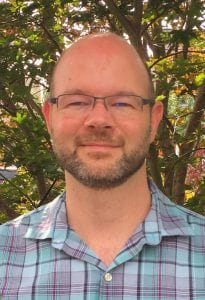In this interview, we chat with Ray Schaak, ACS Nanoscience Au’s Deputy Editor, about his research interests, the value of open access, and key components of a high-quality research paper.

ACS Nanoscience Au launched in January 2021. This broad-scope open access journal provides nanoscientists and technologists with a high-quality outlet for their research if they want to publish open access or if their funder requires them to do so.

So, Ray – what drew you to nanoscience?
My Ph.D. research in Tom Mallouk’s lab and my postdoctoral research in Bob Cava’s lab focused mostly on solid-state chemistry, using very high temperatures to make a lot of interesting bulk-scale inorganic compounds. There was very little nano in my research at that time! But I was really interested in developing chemical pathways for making new solid-state compounds that couldn’t be made at high temperatures, and nanoscience provided some intriguing opportunities for doing so. Nanoparticles are much more reactive than the bulk powders that are used as reagents in high-temperature solid-state synthesis, so I became interested in nanoparticle chemistry as a way to make new solid-state compounds at lower temperatures. That is what drew me to nanoscience!
What were the biggest challenges for you in developing a research career?
Starting a research career at an academic institution requires diving into many new things, quickly and at full speed! It also requires learning on the fly, learning from others, and learning from mistakes. I found those aspects to be both exciting and challenging. As an introvert, one of my biggest challenges was networking and seeking out others, especially people who I didn’t already know. I found myself stepping outside of my comfort zone frequently, and that continues today! Another challenge, especially early on, was knowing when to pursue certain research ideas and when to not pursue others.
Do you have any tips for aspiring researchers to help them develop their careers?
Consider not only the research but also the researchers. Assemble a team of people, at all levels of training, who think differently than you. Diverse backgrounds, perspectives, opinions, knowledge, and expertise can be extremely valuable for tackling problems creatively. Be open to new ideas and new directions. Find a research problem you are passionate about studying and tackle it with what is needed to make it happen, even if it is outside your comfort zone or requires you to learn new skills.
What does open science mean for you as a researcher?
Open science means ensuring the widest possible audience for research. This includes other researchers, but it also includes the general public. I can’t help but think of two frequently occurring scenarios in my world that help to shape my view of open science. The first is when non-scientist friends find something research-related on the internet. It’s great when papers describing high-quality and impactful research are rigorously peer-reviewed by experts, are freely available, and make it into their hands! The second is when I see students choose to read, discuss, and/or report on papers that are open access simply because they could download them on their mobile devices without being behind a paywall. In both scenarios, people’s perception of science, and their understanding of it, can be shaped by research papers that are freely available.
As the Deputy Editor of ACS Nanoscience Au, what are you looking for in a paper?
At ACS Nanoscience Au, we are looking for exciting and high-quality new research in nanoscale science and technology that bridges fields and pushes them forward in new directions. We are also excited to see forward-looking reviews and perspectives that set the stage for future advances. The nanoscience and nanotechnology community spans a broad scope of disciplines, so top papers are able to speak across disciplines and be readable by researchers in fields beyond those of the authors.
Finally, if we could grant you one superpower: what would it be, and why?
Teleportation! If I could “beam” from one place to another instantaneously, travel would be streamlined, and I could be anywhere in the world at any time and still keep my house as my “home base.”
ACS Nanoscience Au is ready to receive your research. It will be subject to the same robust, fair, and efficient peer review of all ACS journals to ensure it promotes science that truly progresses nanoscience and nanotechnology. And open access brings the main benefit that all interested readers have instant access, meaning your work can make a greater impact in less time.
